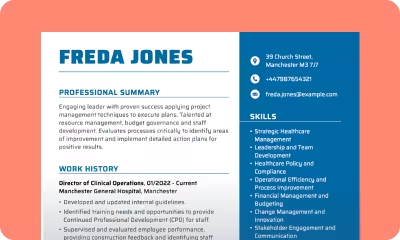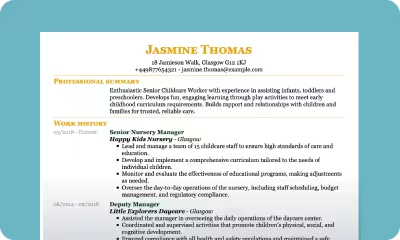- Our customers have been hired by : *Foot Note
The special needs teaching assistant CV sample will help you no end to secure the job you want by enabling you to submit your CV along with your application form in a format that’s professional and contains top-quality content. This will accurately reflect your experience, skills, and knowledge for the job.
Building your CV using this sample will make a positive impression on those shortlisting candidates for an interview, so you’re more likely to be amongst the chosen few.
Before moving on to details, we recommend looking through some CV templates for your application. There’s a wealth of professional layouts to browse, each designed to make you stand out from the competition. Once you’ve found a style that suits your preferences, keep reading as we explore:
SEARCH ALL CV EXAMPLES
Sample special needs teaching assistant CV
Sam Marks
Bradford, 45 Haim Close B45 8GWA
07912345678
Sam.Marks@example.co.uk
Professional summary
Compassionate individual with desire to work with disabled and mentally challenged students. Excited to shadow head teacher in developing curriculum and creating course materials. Patient in handling challenging situations and willing to work extra mile to achieve goals.
Work history
January 2020 – Current
United, Special Needs Private School – Bradford
Special Needs Teaching Assistant
- Planned and arranged classrooms effectively, consistently promoting the inclusion of equal access to learning and development opportunities.
- Assessed students’ motor, language and emotional skills through appropriate developmental screenings.
- Assisted students to reach social development milestones.
February 2018 – January 2020
Homemead School – Bradford
Teaching Assistant
- Supervised students to maintain adherence with health and safety requirements, inside and outside classroom environments.
- Cultivated close working relationships with students, teaching staff and parents, working collaboratively to achieve exam success.
- Performed administrative activities such as taking attendance, marking assignments and maintaining student records.
Skills
- Classroom management support
- Individual Education Plan (IEP) support
- Special education support
- Social activity programs
- Student engagement techniques
- Differentiated instruction
Education
2018
Bradford College Bradford
NVQ Level 2 Teaching Assistant
What is the best format for your special needs teaching assistant CV?
It doesn’t matter how compelling your content is if you don’t present it in an easy-to-read manner. Cue CV formats – professional layouts that define and organise information for maximum readability.
Why are CV formats so important? Quite simply, messy applications make an awful first impression – hiring managers won’t waste time on candidates who don’t seem to care. Most importantly, CV reading software prefers clear fonts, sections, and headings.
There are two widely accepted formats to choose from – the reverse-chronological CV and the skills-based CV. The former highlights work history, starting from your current or most recent role, while the latter focuses on umbrella skills.
Both have their place, but the reverse-chronological CV often packs a mightier punch. Employers prioritise applicants with experience, especially when working with young people in educational settings.
Alongside choosing the correct layout, there are a few key things to remember as you complete the following sections. Your special needs teaching assistant CV should only be one to two pages long, so avoid meaningless waffle. Plus, use fonts like “Times New Roman”, “Arial”, and “Calibri” to improve legibility, and send your application as a Word or PDF file unless asked otherwise.
How to write a CV for a special needs teaching assistant
Wondering how to write a CV for a special needs teaching assistant? Simply implement the below advice. We’ll answer your most pressing questions and share countless tips for impressing busy hiring managers.
Above all else, don’t rush the process – set aside some time to craft your CV, taking regular breaks to brainstorm ideas about your abilities and experience. Keep reading as we run through:
- How to add contact details to your special needs teaching assistant CV
- Start your special needs teaching assistant CV with a personal statement
- How to present your work history on a special needs teaching assistant CV
- Great skills to add to your special needs teaching assistant CV
- How to add education to your special needs teaching assistant CV
How to add contact details to your special needs teaching assistant CV
Many candidates are so excited to tackle the meatier sections of their special needs teaching assistant CV that they forget to add their current contact details. It might seem like a minor oversight, but it makes it impossible for hiring managers to contact you about the next steps. Hold your horses and ensure to include the following information:
- Full name
- Location
- Phone number
- Email address
Alongside noting these details at the top of your CV, you might like to use a slightly bolder font. Plus, keep it work-appropriate – you’d be surprised how many applicants reach out with silly or even offensive email addresses!
Example of contact section for a special needs teaching assistant CV
Sarah Turner,
10 The Street,
Anytown,
Anycounty, AN92 7HF
07956 333 121
sarahturner@mailservice.com
Start your special needs teaching assistant CV with a personal statement
Want to stand out from the fierce competition? Create a persuasive personal statement that spotlights your top qualities and proudest accomplishments. This punchy three to four sentence opening paragraph should explain who you are, including years of experience and career focus, what you can achieve, and the unique skills that make you the best person for the job.
You don’t want to overwhelm the reader with pointless information, so keep it short and to the point. Other top tips include:
- Write in the third person to sound more professional
- Use plenty of positive adjectives like “patient” and “motivated”
- Mention any specialisms, such as children with autism
- Avoid jokes – special needs teaching is serious stuff
- Double-check for spelling or grammar mistakes
If you really want to give your special needs teaching assistant CV the wow factor, substantiate claims with facts and figures. For instance, you might have “created exciting learning material that helped 12 children in the class reach their KS3 reading milestones”.
Example of personal statement for special needs teaching assistant CV
OR
A dedicated special needs teaching assistant who works to promote student independence. Has a special insight into conditions such as dyslexia, autism, and Asperger’s syndrome, as well as other learning disabilities and physical disabilities. Supports students with activities between lessons, including personal care and mealtimes. Can work 1:1 with challenging students. Has been trained in techniques to safely manage challenging behaviour and has undertaken extensive workplace health and safety training. Is passionate about promoting each individual student’s independence and development.
How to present your work history on a special needs teaching assistant CV
Employers love the work history section because it boasts priceless information that proves your suitability. Underneath each position, you’ll outline your key responsibilities and strengths, demonstrating your aptitude for the role. The reader can also discern how long you usually stay with an organisation and whether you consistently exceed expectations via noteworthy accomplishments, like promotions and awards.
As recruiters will spend the most time here, carefully craft each word! Starting from your current or most recent position, run through:
- Job title
- Employment dates
- Company name and location
- Short list of responsibilities
- Noteworthy accomplishments
How many duties should you list for each role? We recommend including up to six for more recent positions and around three for older ones. Keep the information relevant – re-read the job description, get an idea of what the employer is looking for, and use that as inspiration.
Additionally, avoid repetition – not only is it boring, but it’ll portray you as a one-trick pony! If you’ve mentioned “lesson planning” underneath one job, then talk about “administration” in another. Highlighting a collection of duties will show the employer that you’re well-rounded and multi-talented.
Lastly, like the personal statement, blow the hiring manager away with dazzling facts and figures. You could mention how many students you supported during a term or explain how your class materials helped children to reach their milestones. Either way, it’s far more convincing to show the employer how amazing you are rather than simply telling them.
Example of work experience for a special needs teaching assistant CV
Special Needs Teaching Assistant | The Special School, Manchester | September 2010 – present
- Supporting the class teacher and individual special needs students with day-to-day teaching and learning.
- Participating in a range of lessons from physical to creative.
- Participating in assemblies, staff meetings, and end-of-term concerts.
- Communicating information about individual students back to the class teacher so learning plans and risk assessments can be updated
- Managing incidents of challenging behaviour.
Teaching Assistant | Homemead School, Manchester | September 2005 – July 2010
- Supported individual special needs students and the class teacher in a mainstream school.
- Liaised with parents about progress and ongoing development plans.
- Designed brand-new speech therapy materials.
Great skills to add to your special needs teaching assistant CV
Win over the grouchiest hiring managers with a glowing CV skills section that confirms you have the core expertise to hit the ground running. It’s a fantastic opportunity to summarise your most desirable qualities through job-specific hard skills and transferable soft skills.
Hard skills are technical and teachable, often learnt via school, college, or university, certification programmes, training courses, or on the job. They might include “creating special needs class materials”, “carrying out risk assessments”, and “supporting children with autism”.
In contrast, soft skills are personality-based and much harder to develop – think “excellent communicator”, “problem-solver”, and “empathetic listener”. Soft skills are equally important because they reassure employers that you’d be a good fit for the organisation and team.
We advise blending hard and soft skills to stand out from the crowd. Include up to 12 in total, split equally between the two. Stuck for ideas? Read through the following lists:
Essential skills for a special needs teaching assistant
- Understands the learning process for special needs students with a range of mental and physical special needs and learning disabilities
- Can employ a range of learning support techniques to suit individuals
- Can understand and follow lesson plans
- Health and safety trained, including first aid, manual handling, and challenging behaviour
- Excellent team member with strong communication skills
Desirable aptitudes to set you apart
- Excellent administration and IT skills
- Patience and the ability to remain calm in stressful situations
- Committed to ongoing training and development
- Active listening skills
- Calming and approachable manner
How to add education to your special needs teaching assistant CV
Education is the foundation of experience, and possessing the right qualifications will set you apart from other candidates. Alongside school, college, and university, you can talk about outside training courses and certificates. Don’t be shy – this is your chance to shine and shout about what gives you the competitive edge!
How do you become a special needs teaching assistant? The most popular route is via a Level 2 and 3 Certificate in Supporting Teaching and Learning in Schools, Level 3 Diploma in Childcare and Education Early Years Educator, or T Level in Education and Childcare. Contact your local college for more information.
Alternatively, learn on the job with an apprenticeship. Some schools offer intermediate and advanced apprenticeships to people who already have some experience in a school environment or with special needs children.
Either way, you must demonstrate a keen understanding of academia – after all, you’ll be in charge of a child’s learning and development. When outlining your education, include:
- Name of school, college, university, or other awarding body
- Study dates
- Course title
- Qualification level – e.g. GSCE or T Level
- Qualification result
Example of education for special needs teaching assistant CV
Manchester College | 2002 – 2004
Teaching Assistant NVQ Level 2
Manchester High School | 1997 -0 2002
8 GCSEs, including English (C), Maths (C), and General Studies (C)
Special needs teaching assistant dos and don’ts
DO
DO: focus on soft skills
The most experienced candidates won’t go far without the right personality-based soft skills. Special needs teaching assistants must be caring and patient with a knack for handling stressful situations. While rewarding, the position isn’t always easy, and you must demonstrate how you’ll cope with the pressure.
DO: mention your specialism
There are numerous conditions of varying severity that sit underneath the special needs umbrella. Children with autism require a different approach than children with speech delays. Some students might have additional physical disabilities or need specific learning equipment like text-to-speech readers. It’s best to outline any specialisms in your personal statement to reiterate your strengths.
DON'T
DON’T: send your application without spell checking
It wouldn’t look good to send an application with spelling and grammatical errors, especially because you’re applying for a position in education. Run your special needs teaching assistant CV through a free spell-checker to save yourself the embarrassment!
DON’T: lift text directly from the job description
Although schools look for specific qualities, resist the temptation to lift text directly from the job advertisement. Instead, be as authentic as possible. Talk about what makes you truly unique, such as non-essential training courses or the time you undertook a project outside your contracted responsibilities.
Your special needs teaching assistant CV questions answered
What does a special needs teaching assistant do?
Special needs teaching assistants support teachers in helping children with additional educational needs and disabilities. Some work in special needs schools, while others assist students within mainstream schools. Whatever the location, day-to-day responsibilities include:
- Preparing and teaching learning materials
- Liaising with parents, other teachers, and therapists
- Managing challenging behaviour
- Building a child’s confidence
- Supporting a child’s emotional wellbeing
Can you be a teaching assistant with no qualifications?
There are no compulsory qualifications for becoming a teaching assistant. Nevertheless, the competition is intense, and most candidates will have some experience or relevant training. We recommend completing a college course or apprenticeship to give yourself the best chance possible.
Is being a SEN teacher hard?
Every job has its highs and lows, and being a special educational needs (SEN) teaching assistant is no different. Many children experience uncontrollable frustration when they don’t understand a subject. Plus, behavioural problems can accompany developmental delays. Consequently, you must be able to handle outbursts and stressful situations.
How much do SEN teaching assistants get paid in the UK?
It’s impossible to predict how much you’ll get paid as a SEN teaching assistant because wages depend on location, expertise, and qualifications. However, SEN teaching assistants usually earn more than regular teaching assistants because the role is more complex. Entry-level positions start around £21,000 and rise to £36,000 with experience.
Create a special needs teaching assistant CV using our online tools
myPerfectCV makes it quick and easy to build a special needs teaching assistant CV that headteachers and recruiters will love. Take a look at our CV examples for a range of SEN and teaching roles then select one of our customisable CV templates to get started on your application. There are plenty of options that are perfect for SEN teaching jobs, along with pre-written content in our CV builder which can be filtered to match your experience and skills.
*The names and logos of the companies referred to above are all trademarks of their respective holders. Unless specifically stated otherwise, such references are not intended to imply any affiliation or association with myperfectCV.




